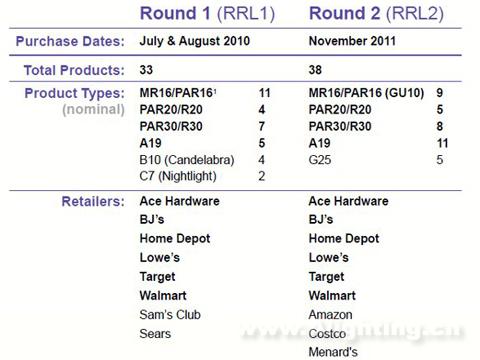The latest round of SSL light bulb experiments conducted by the US Department of Energy involved 38 products. In the report of the Strategies in Light (SIL) conference, it was pointed out that the lumen output and CRI were generally improved.
Building on the work of the Pacific Northwest National Laboratory (PNNL), the US Department of Energy (DOE)'s new round of LED bulb tests includes sample reports for the A19, G25, MR16, PAR20, and PAR30 samples from nine anonymous retailers. Procurement from 18 different manufacturers. After a 14-month SSL retrofit test, the PNNL report indicated that the average cost per 1,000 lumens dropped from US$130/kilometer to US$63/kilohm.

Latest LED bulb test results released by DOE
The PNNL conducted three samples of each lamp and used an integrating sphere for the LM-79 photometric tests. These bulbs were purchased in the summer of 2011 and tested in the fall. According to the report, these bulbs have light efficiencies ranging from 36 lumens/watt to 72 lumens/watt with an average of 53 lumens/watt. Both the minimum and maximum light efficiency have risen, and the range of light efficiency is still wide. It is expected that the range of light efficiency changes will increase in the future. This is because manufacturers are looking for different product types and application requirements.
The test included 11 samples of A19. The luminous efficiency of these samples was close to 60 lumens/watt. The efficacy of a bulb with a power consumption of less than 10 watts was 50 to 55 lumens/watt, and the efficacy of a lamp with a power greater than 10 watts was 55 to 70 lumens/watt. watt. Compared to the previous round of testing, the maximum difference was 20 lm/W. In this test, the Department of Energy first evaluated the G25 sample, with a luminous efficiency of 35 to 55 lumens/watt. The report shows that although the LED G25s are better than halogen lamps, the energy-saving lamp is more suitable for use in store shelf lighting. The test results of the MR16 and PAR20 LED samples are good. The efficacy of the eight PAR30 samples tested is floating up and down in the energy-saving lamp, and the luminous efficacy is 50-55 lm/W.
The color temperatures ranged from 2500K to 6000K for all samples tested, and most samples were in the 2700-3000K range. In the whole test, the color rendering difference is significant, and the color rendering of the lower price is poor. The color rendering index of some samples is less than 70, and most of the samples are about 80.
However, some samples in the test product had size and shape issues. Six of the 11 A19 bulbs did not meet the American National Standards Institute (ANSI) specifications. Two of the five PAR20 samples were too long, and nine of the PAR30 samples contained 4 dimensions are too long.
The report also pointed out that most manufacturers seem to focus on high-lumen luminaires, but apartments and small rooms require less light output, and it is difficult to find light bulbs with 400 lumens on the market.
Zysen offer directional coupler and dual directional coupler. Up to 50GHz, narrow band and broard band are available, Connector type SMA,N,2.92mm,2.4mm are optional. Customized frequency and optimized specifications available. Contact us with your requirement.
Directional Coupler Price,Dual Directional Coupler,Broadband Directional Coupler,Wideband Directional Coupler
Chengdu Zysen Technology Co., Ltd. , https://www.zysenmw.com